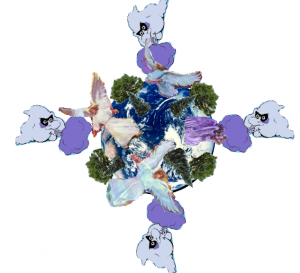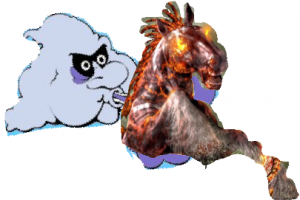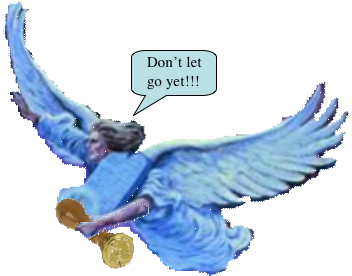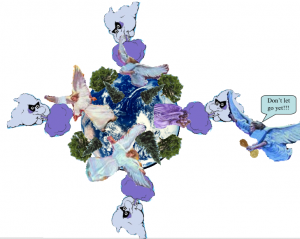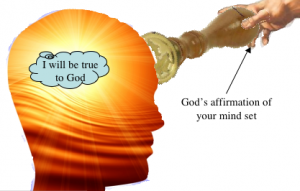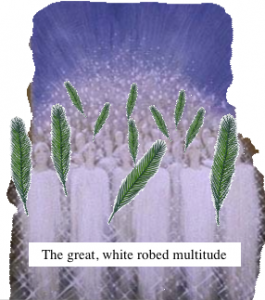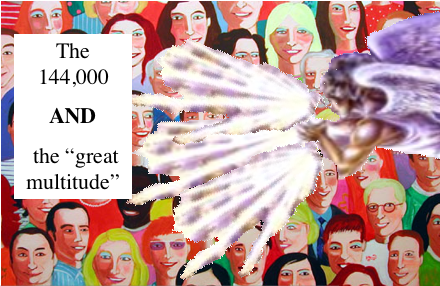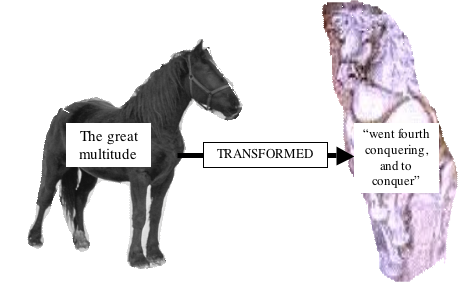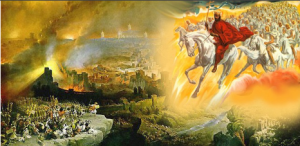“Now there is a pause in the opening of the seals, for a question must be answered. Thus far in the portrayal of the terrible events that preceded the second advent, no indication has been given that anyone survives them. Hence the dramatic question, ‘Who shall be able to stand?’ Chapter 7 breaks the sequence of the seals in order to present [the] answer.” [1] Consequently, John takes us back, retrospectively, to the time between Verses 13 and 14 of the last chapter―after “the stars of heaven fell unto the earth” in 1833 and when “the heaven departed as a scroll.”
Several events took place during that intervening period, the most important, which is also history, is the inauguration of the Investigative Judgment when “one like the Son of man came . . . to the Ancient of days” “and he came and took the book out of the right hand of him that sat upon the throne” at the end of the 2300 days (see Daniel 7:13; Revelation 5:7 and Daniel 8:14) October 22, 1844, some ten years after “the stars of heaven fell unto the earth” (Revelation 6:13).
Then, those “who shall be able to stand” will be chosen after the judgment has passed from the dead to the living. We will know that important moment has arrived when the events connected with the opening of the “fifth seal” (Revelation 6:9-11) begin to transpire, because it is the “test that the people of God must have before they are sealed.” [2]
Verse 1: And after these things I saw four angels standing on the four corners of the earth, holding the four winds of the earth, that the wind should not blow on the earth, nor on the sea, nor on any tree.
These “angels” are good angels because they are restraining the “four winds,” representing, in general, the global forces of evil and, specifically, “the efforts of Satan to spread ruin and destruction everywhere.” [3] “John sees the elements of nature—earthquake, tempest, and political strife—represented as being held by four angels. These winds [4] are under control until God gives the word to let them go.” [5] The holding of the four winds, of course, is what is going on right now.
Here is a graphic description of what the “four winds” represent: “Angels are holding the four winds, represented as an angry horse seeking to break loose, and rush over the face of the whole earth, bearing destruction and death in its path . . .” [6]
Recall the violent “red” and “pale” horses, featured in the second and fourth seals (Revelation 6:4, 8), which match that description quite well. Astride them sits Satan, the enemy of all souls good or bad.
“It has been suggested that inasmuch as Rev. 7 appears to be an answer to the final question of ch. 6, this holding of the four winds is a temporary withholding of the terrors depicted in ch. 6, until those who are to stand firm in the tempest have made preparation for it.” [7]
But there are other things preceding the second coming which the saints must be prepared for, namely, the “time of trouble,” inclusive of a destructive rampage the likes of which will have never been seen “since there was a nation even to that same time” (Daniel 12:1), coupled with the 1335 “days” (Daniel 12:12) [8] that the saints must endure before the special resurrection. God, through John, tells us about them, not to frighten us, but because he loves us and wants us to know what to expect and be prepared to face them.
Verse 2: And I saw another angel ascending from the east, having the seal of the living God: and he cried with a loud voice to the four angels, to whom it was given to hurt the earth and the sea,
Who is this “angel ascending from the east”? He is “The Angel of the covenant. He comes from the sunrising. He is the Dayspring from on high. He is the Light of the world. ‘In Him was life; and the life was the light of men’ (John 1:4). This is the One Isaiah describes: ‘Unto us a Child is born, unto us a Son is given: and the government shall be upon His shoulder; and His name shall be called Wonderful, Counselor, The mighty God, The everlasting Father, The Prince of Peace’ (Isaiah 9:6).” [9] Therefore, Christ is this other “angel.”
His cry “with a loud voice” is suggestive of the cry of “the third angel” who also says “with a loud voice, if any man worship the beast and his image, and receive his mark . . . the same shall drink of the wine of the wrath of God . . .” (Revelation 14:9-11).
Therefore, this cry must refer to the “fifth seal” scenario (Revelation 6:9-11), and also the “tidings out the east and out of the north” that trouble “the vile person” who has “intelligence with them that forsake the holy covenant,” after which “they shall place the abomination that maketh desolate” (Daniel 11:21, 30, 31, 44).
Evidently, the “four angels” who were “given to hurt the earth and the sea,” could “hurt them” by releasing the “four winds” they had been restraining. This is serious because: “Were it not that God has commanded angelic agencies to control the satanic agencies that are seeking to break loose and to destroy, there would be no hope. But the winds are to be held until the servants of God are sealed in their foreheads.” [10]
Since there will be “no hope” after their release means that the “four winds” will “blow” unrestrained after the close of probation. Therefore, as long as the “four winds” are being restrained or held back, probationary time will linger.
Verse 3: Saying, Hurt not the earth, neither the sea, nor the trees, till we have sealed the servants of our God in their foreheads.
“When the four angels finally let go and cease holding in check the malicious designs of Satan and ‘the fierce winds of human passion, all the elements of strife will be let loose. The whole world will be involved in ruin more terrible than that which came upon Jerusalem of old.’” [11] The command “Hurt not” is expressive of divine reluctance to allow that which will hurl “the kings of the earth . . . the great men, and the rich men, and the chief captains, and the mighty men, and every bondman, and every free man” to their doom (Revelation 6:15).
“The sealing is a pledge from God of perfect security to His chosen ones. Sealing indicates you are God’s chosen. He has appropriated you to Himself.” [12] What is the “seal”? “―it is not any seal or mark that can be seen, but a settling into the truth, both intellectually and spiritually, so they cannot be moved.” [13]
“It is a mark which angels, but not human eyes, can read; for the destroying angel must see this mark of redemption. The intelligent mind has seen the sign of the cross of Calvary in the Lord’s adopted sons and daughters. The sin of the transgression of the law of God is taken away. They have on the wedding garment, and are obedient and faithful to all God’s commands.” [14]
“Satan is now using every device in this sealing time to keep the minds of God’s people from the present truth, and to cause them to waver. I saw a covering that God was drawing over his people to protect them in the time of trouble; and every soul that was decided on the truth, and was pure in heart, was to be covered with the covering of the Almighty.” [15]
“The bottles of God’s wrath cannot be poured out to destroy the wicked and their works until all the people of God have been judged, and the cases of the living as well as the dead are decided. And even after the saints are sealed with the seal of the living God, His elect will have trials individually. Personal afflictions will come; but the furnace is closely watched by an eye that will not suffer the gold to be consumed. The indelible mark of God is upon them. God can plead that His own name is written there. The Lord has shut them in. Their destination is inscribed— ‘God, New Jerusalem.’ They are God’s property, His possession.” [16]
There will be no neutral ground. “All who prove their loyalty to God by observing his law, and refusing to accept a spurious Sabbath, will rank under the banner of the Lord God Jehovah, and will receive the seal of the living God. Those who yield the truth of heavenly origin, and accept the Sunday Sabbath, will receive the mark of the beast.” [17]
Therefore, all will be “sealed”; either with the “mark of the beast,” or God’s “seal.” His sealing does not in any way infringe on the power of choice. Rather, God will stake His reputation on the firmness of your decision to be loyal to Him no matter what! Even Satan will marvel at God’s audacity. If any one of the sealed saints should waver, Satan would win the last battle in the final conflict!
Verse 4: And I heard the number of them which were sealed: and there were sealed an hundred and forty and four thousand of all the tribes of the children of Israel.
Note the first words of this verse: “I heard the number . . .” Then compare with the first words of Verse 9: “After this I beheld . . .” John did not see the group numbered as the 144,000, but he did see the great, unnumbered multitude. That suggests that the 144,000 are designated as a special group of people within the great multitude. Therefore, it seems that the experience of both groups is essentially the same, except that the 144,000 are “the people that do know their God . . . “and instruct many” (Daniel 11:32), the many apparently being the “great multitude, which no man could number” (Verse 9). Note also, “these are they that come out of great tribulation” (Verse 14). indicating that both groups share the same tumultuous experience.
Following the concept of the four apocalyptic horses, representing the characters of people on earth: in the final hours of earth’s history, 144,000 white horse people will “instruct” the “many” black horse people, designated here as the “great multitude.”
The 144,000 are a special group “from among the living” [19] whom God alone will select to stand throughout the time of trouble. They will welcome the “Lamb” when He “shall descend from heaven with a shout, and with the voice of the archangel” (1 Thessalonians 4:16), saying: “Lo, this is our God; we have waited for him, and he will save us: this is the LORD; we have waited [20] for him, we will be glad and rejoice in his salvation” (Isaiah 25:9).
Verses 5-8: Of the tribe of Juda were sealed twelve thousand. Of the tribe of Reuben were sealed twelve thousand. Of the tribe of Gad were sealed twelve thousand. Of the tribe of Aser were sealed twelve thousand. Of the tribe of Nepthalim were sealed twelve thousand. Of the tribe of Manasses were sealed twelve thousand. Of the tribe of Simeon were sealed twelve thousand. Of the tribe of Levi were sealed twelve thousand. Of the tribe of Issachar were sealed twelve thousand. Of the tribe of Zabulon were sealed twelve thousand. Of the tribe of Joseph were sealed twelve thousand. Of the tribe of Benjamin were sealed twelve thousand.
Even though Verse 4 stipulates these to be the names “of all the tribes of the children of Israel,” the names of two outstanding tribes are missing here, and two are added to preserve the number.
Going back to the book of Numbers, we find four leading tribes were listed under what Moses called “standards.” First, “on the east side” was “the standard of the camp of Judah.” Next “on the south side” was “the standard of the camp of Reuben.” Then, “on the west side” was “the standard of the camp of Ephraim.” Last, “the standard of the camp of Dan” was “on the north side” (see Numbers 2:3, 10, 18, 25).
Only two leading tribes, Juda and Reuben, are listed with the 144,000, while Dan and Ephraim are missing. The Commentary suggests: “Perhaps Dan was excluded because of that tribe’s reputation for idolatry.” And “To reckon Levi and yet retain the number 12 it was necessary to omit one of the tribes, inasmuch as Joseph was reckoned as two tribes, namely Ephraim and Manasseh.” [21] So, from that standpoint, Ephraim was arbitrarily omitted and Manasses retained. Perhaps there is another explanation.
According to Jewish tradition, the emblem on the standard of the camp of Judah, was a lion; camp of Reuben, the face of a man; Ephraim, the face of an ox; and Dan, the face of an eagle [22] which coincides with the appearances of the “four beasts” (Revelation 4:7), all of whom invited John to “Come and see” the four horses of the apocalypse (Revelation 6:1-8).
Interestingly, the “beast with the face of a calf” is associated with “Ephraim,” and the other “like a flying eagle,” is associated with “Dan.” Note that the “beast” who introduced the “horse that was red” is associated with Ephraim and the “beast” who introduced the “pale horse” is associated with Dan.
As we just learned, the “red” and “pale” horses are controlled by Satan. The “white” and “black” horses, introduced by the “beasts” with the faces of a “lion” and a “man,” are controlled by Christ and are associated with Juda and Reuben. Therefore, there is good reason to eliminate the two leading tribes of Ephraim and Dan.
Another interesting side note is found in Ezekiel 41: 18, 19 where two “cherubim” are depicted facing “toward the palm tree” with that of “the face of a man . . . toward the palm tree on the one side, and the face of a young lion toward the palm tree on the other side” but, nothing is said of the “calf” or the “eagle.”
The Christian is like the “palm tree.” “He must stand upright like the palm tree in the desert. The sky may be as brass, the desert sand may beat about the palm tree’s roots, and pile itself in heaps about its trunk. Yet the tree lives as an evergreen, fresh and vigorous amid the burning desert sands. Remove the sand till you reach the rootlets of the palm tree, and you discover the secret of its life; it strikes down deep beneath the surface, to the secret waters hidden in the earth.” [23]
The symbol of the “palm tree” represents the character of the overcomer, who is victorious in spite of the adverse circumstances that surround him. It signifies victory in the lives of the people that the “cherubim/beast” with “the face of a man” invites us to “come and see” and the “cherubim/beast” with the face of a lion” invites us to “come and see” (Revelation 6:1, 5). So, what happens after the saints are sealed? Obviously, the “earth, sea, and trees” will be “hurt” (Verse 3). But wait, there is more before that happens!
Verse 9: After this I beheld, and, lo, a great multitude, which no man could number, of all nations, and kindreds, and people, and tongues, stood before the throne, and before the Lamb, clothed with white robes, and palms in their hands;
Note that John only “heard the number of them which were sealed . . . an hundred and forty and four thousand . . .” (Verse 4) but, here, he “beheld” (or “saw”) this “great multitude, which no man could number,” suggesting the 144,000 were a part of the “great multitude” and they all looked alike!
The Commentary suggests three main views of the “great multitude:”
1) “the 144,000 and the ‘great multitude’ . . . are not differences, but explanations: thus the fact that the ‘great multitude’ cannot be numbered” implies “that the number 144,000 is symbolic rather than literal.”
2) emphasizes “the differences between the 144,000 and the ‘great multitude.’ One is numbered, the other cannot be. One represents a special group, ‘the first fruits unto God and to the Lamb’ who ‘follow the Lamb whithersoever he goeth’ (ch. 14:4), the other, the remaining triumphant saints of all ages.”
3) “the ‘great multitude’ as the entire company of the redeemed, including the 144,000.” [24]
While we may personally favor one over the other, we should try to take all the facts into consideration before making up our minds. Since John only “heard” the number of the 144,000, and then “saw” the “great multitude,” it is difficult, if not impossible, to distinguish one group from the other.
White appears to support view 2) saying, in context with the postmillennial scenario of Revelation 21: “those who honored the law of God when the Christian world declared it void, and the millions, of all ages, who were martyred for their faith. And beyond is the ‘great multitude, which no man could number, of all nations, and kindreds, and people, and tongues . . . before the throne, and before the Lamb, clothed with white robes, and palms in their hands.” [25] That statement portrays a post millennial scene, while this is clearly premillennial.
In another passage she quotes Revelation 7:9-17 in context with the time when “we could not buy or sell” and the wicked were exalting that “the temporal millennium . . . they had been expecting so long” was, in their view, being fulfilled. They accused the faithful “while anguish was upon” them “who would not worship the beast or his image and accept and revere an idol Sabbath . . .” [26] That statement moves Verse 9 into premillennial time, or before the millennium, placing it in context with the “fifth” as well as the “sixth seal” scenarios. [27]
If, therefore, the 144,000 and the “great multitude” cannot be separated from each other, why is such importance attached to the numbered 144,000 group of people that John could not identify visually?
Here is another helpful statement: “Why were they the 144,000 so specially singled out? Because they had to stand with a wonderful truth right before the whole world, and receive their opposition, and while receiving this opposition they were to remember that they were sons and daughters of God, and that they must have Christ formed within them the hope of glory.” [28]
What does it mean “to stand with a wonderful truth right before the whole world . . .”? Obviously, to preach. What message would they preach? It would be the three angels’ messages (Revelation 14:6-9) that are depicted in the context of the “hundred forty and four thousand” who, among other things, are called “the firstfruits unto God and to the Lamb” (Revelation 14:1, 4).
Therefore, it is clear that this “great multitude, which no man could number, of all nations, and kindred, and people and tongues,” is the result of the efforts of the 144,000 to evangelize “with a wonderful truth right before the whole world.”
This harmonizes well with “the people [the 144,000] that do know their God shall be strong, and do exploits. And they that understand among the people [the 144,000 again] shall instruct many” [the ‘great multitude’] (Daniel 11:32, 33). This also rounds out Daniel 11:44 where “tidings” [by the 144,000] are heard “out of the east and out of the north [that] shall trouble him [the vile person]: therefore he shall go forth with great fury to destroy, and utterly to make away many [the ‘great multitude,’ inclusive of the 144,000].”
This will be the ultimate fulfillment of Isaiah 55:11: “So shall my word be that goeth forth out of my mouth: it shall not return unto me void, but it shall accomplish that which I please, and it shall prosper in the thing whereto I sent it.”
Verse 10: And cried with a loud voice, saying, Salvation to our God which sitteth upon the throne, and unto the Lamb.
This cry seems to be uttered at the same time others cry “to the mountains and rocks, Fall on us, and hide us from the face of him that sitteth on the throne, and from the wrath of the Lamb.” (Revelation 6:16).
This cry of the great multitude is an echo of “the song of Moses” (Revelation 15:3) when “Israel saw that great work which the LORD did upon the Egyptians: and the people feared the LORD, and believed the LORD, and his servant Moses. Then sang Moses and the children of Israel this song unto the LORD, and spake, saying, I will sing unto the LORD, for he hath triumphed gloriously: the horse and his rider hath he thrown into the sea. The LORD is my strength and song, and he is become my salvation: he is my God, and I will prepare him an habitation; my father’s God, and I will exalt him. The LORD is a man of war: the LORD is his name. Pharaoh’s chariots and his host hath he cast into the sea: his chosen captains also are drowned in the Red sea” (Exodus 14:30 – 15:4).
In context with that thought, God will have just rescued the “great multitude” from certain death at the hands of the wicked in the very last moment of earth’s history when “a universal decree will denounce these as deserving of death.” [29] Instead of the Egyptians, God’s people will behold “the kings of the earth, and the great men, and the rich men, and the chief captains, and the mighty men, and every bondman, and every free man, hid[e] themselves in the dens and in the rocks of the mountains” (Revelation 6:15) that the “great multitude” had just been hiding in!
In the symbolism of the white and black horses (Revelation 6:2, 5), we can assume the great multitude to be represented by the black horse. Many of the great multitude of the world are doing the best they can in spite of their ignorance. They will be transformed into the white horse who goes forth “conquering and to conquer” because they will accept the “loud cry” of the three angel’s messages given by the 144,000, the final message of mercy to a lost world.
Verses 11 & 12: And all the angels stood round about the throne, and about the elders and the four beasts, and fell before the throne on their faces, and worshipped God, Saying, Amen: Blessing, and glory, and wisdom, and thanksgiving, and honour, and power, and might, be unto our God for ever and ever. Amen.
Note the similarity of this scene to where John “beheld, and . . . heard the voice of many angels round about the throne and the beasts and the elders . . . saying, Blessings, and honour, and glory, and power, be unto him that sitteth upon the throne, and unto the Lamb for ever and ever” (Revelation 5:11, 13), just after the “Lamb . . . came and took the book out of the right hand of him that sat upon the throne” (Revelation 5:7).
Since that “book” contained the “influence of every nation, tongue, and people from the beginning of earth’s history to its close,” [30] they were celebrating the commencement of the judgment (October 22, 1844, at the end of the 2300 days of Daniel 8:14) that could not have begun without the blood of the “Lamb as it had been slain” enabling Him “to open the seals thereof” (Revelation 5:6, 9).
Now, John sees the same angels gathered around “the throne . . . elders and the four beasts” to worship God in recognition of His deliverance of the “great multitude” out of “all nations, and kindreds, and people, and tongues” (Verse 9). But, in the next verse, a question is asked of John.
Verse 13: And one of the elders answered, saying unto me, What are these which are arrayed in white robes? and whence came they?
The phraseology here suggests the elder was answering John’s twofold, unspoken question: “who are these white robed people and where did they come from?” [31]
Although there is much debate over the answer to the first part of the question, it, at least, seems clear that the white robed people are identified in Verse 9 as “a great multitude, which no man could number . . . clothed with white robes.” Recall also that this was the only group that John actually saw, according to Verse 9, in contrast to Verse 4 that says he only “heard the number of” the 144,000.
The answer to the second part of the question, “whence [32] came they” or “what condition did they come from?” is less clear. The next verse is helpful:
Verse 14: And I said unto him, Sir, thou knowest. And he said to me, These are they which came out of great tribulation, and have washed their robes, and made them white in the blood of the Lamb.
John, suggesting he was at a loss for the answer, defers to the elder to give the answer as to the origin of this “great multitude clothed with white robes” which were whitened “in the blood of the Lamb.”
The Commentary alludes to two schools of thought regarding which “tribulation” they had endured: 1) “the time of trouble preceding the second advent of Christ mentioned in Dan. 12:1,” or 2) “more generally to the various periods of tribulation the saints have experienced down through the centuries, or, more specifically, to the tribulation portrayed by the symbols of Rev. 6.” [33] Based on the following statement from White, option 2 can be laid to rest. She states: “. . . the hundred and forty and four thousand . . . having been translated from the earth, from among the living, are counted as ‘the first fruits unto God and to the Lamb.’ (Rev. 14:1-5; 15:3) ‘These are they which came out of great tribulation’ (Rev. 7:14-17).” [34] Consequently, from that standpoint, this “great tribulation” is the one “mentioned in Daniel 12:1” which is not only future, but post probationary, after “Michael” stands up.
But, according to Verses 9 and 14, it is the “white robed” multitude which “came out” of the great tribulation, inclusive of the 144,000. But remember, John only “heard” (Verse 4) that number while he actually “beheld” (Verse 9) the “great multitude.” Therefore, we cannot visually separate the 144,000 from the “multitude,” because they too are “arrayed in white robes” making them indistinguishable from the “multitude.” Thus, the “great multitude . . . came out of” the same “great tribulation,” after the close of probation, that the 144,000 also came out of and, therefore, were sealed and translated without seeing death right along with the 144,000! [35] [36] They had “come from the mountains, from the rocks, from the dens and caves of the earth, from dungeons, from prisons, from secret councils, from the torture chamber, from hovels, from garrets. They have passed through sore affliction, deep self-denial, and deep disappointment. They are no longer to be the sport and ridicule of wicked men. They are to be no longer mean and sorrowful in the eyes of those who despise them.” [37]
This “great tribulation” is what Daniel termed “a time of trouble, such as never was since there was a nation even to that same time” (Daniel 12:1) [38], after “Michael [stood] up,” meaning that it takes place during post probationary time. But, how large can we expect the “great multitude” to be? After all: “The people of God . . . are greatly in the minority. In the last days only a remnant exists.” [39]
Consider this passage: “And it shall come to pass, that in all the land, [40] saith the LORD, two parts therein shall be cut off and die; but the third shall be left therein. And I will bring the third part through the fire, and will refine them as silver is refined, and will try them as gold is tried: they shall call on my name, and I will hear them: I will say, It is my people: and they shall say, The LORD is my God” (Zechariah 13:8, 9). What do we learn from that? A “third” of the total world’s population would be more than two billion. [41] That is a “great multitude,” but greatly in the minority compared to the other four billion!
Verse 15: Therefore are they before the throne of God, and serve him day and night in his temple: and he that sitteth on the throne shall dwell among them.
Note the similarity of this scene to the promise made to the Philadelphian overcomers: “Him that overcometh will I make a pillar in the temple of my God, and he shall go no more out” (Revelation 3:12). Although everything in the book of Revelation, after Chapter 3, was written “especially for the last church [which is Laodicea],” [42] it is the characteristics and experience of the Philadelphian church members that will be reflected in the character and experience of God’s people at the end of time when “the synagogue of Satan, which say they are Jews, and are not, but do lie . . . will come and worship before thy feet” (Revelation 3:9), the feet of the saints, sometime after the close of probation. [43]
Verse 16: They shall hunger no more, neither thirst any more; neither shall the sun light on them, nor any heat.
“They have seen the earth wasted with famine and pestilence, the sun having power to scorch men with great heat, and they themselves have endured suffering, hunger, and thirst. But ‘they shall hunger no more; neither thirst any more; neither shall the sun light on them, nor any heat . . .” [44] Scorching with “great heat” is a characteristic of one of the seven last plagues, when “the fourth angel poured out his vial upon the sun; and power was given unto him to scorch men . . . with great heat” (Revelation 16:8, 9).
“The season of distress and anguish before us will require a faith that can endure weariness, delay, and hunger, —a faith that will not faint, though severely tried . . . It is often the case that trouble is greater in anticipation than in reality; but this is not true of the crisis before us. The most vivid presentation cannot reach the magnitude of the ordeal. In that time of trial, every soul must stand for himself before God.” [45]
“Will the Lord forget his people in this trying hour? . . . Though enemies may thrust them into prison, yet dungeon walls cannot cut off the communication between their souls and Christ. One who sees their every weakness, who is acquainted with every trial, is above all earthly powers; and angels will come to them in lonely cells, bringing light and peace from Heaven. The prison will be as a palace; for the rich in faith dwell there, and the gloomy walls will be lighted up with heavenly light, as when Paul and Silas prayed and sang praises at midnight in the Philippian dungeon.” [46]
Verse 17: For the Lamb which is in the midst of the throne shall feed them, and shall lead them unto living fountains of waters: and God shall wipe away all tears from their eyes.
Keep in mind this is still contextual with the sixth seal scenario which is designed to answer the question, “who shall be able to stand?” (Revelation 6:17), even though this scene shows the saints in heaven sometime after the second coming.
Therefore, this is a prospective look forward beyond the sixth seal to show the glorious reward that will accrue to the saints after all has been said and done. The next chapter begins with the opening of the “seventh seal” which foretells many other things that will happen before the saints will actually find themselves being led “unto living fountains of waters” in heaven.
“We need not wait till we are translated to follow Christ. God’s people may do this here below. We shall follow the Lamb of God in the courts above only if we follow him here. Following him in heaven depends on our keeping his commandments now. We are not to follow Christ fitfully or capriciously, only when it is for our advantage. We must choose to follow him. In daily life we must follow his example, as a flock trustfully follows its shepherd. We are to follow him by suffering for his sake, saying, at every step, ‘Though he slay me, yet will I trust in him.’ His life practise must be our life practise. And as we thus seek to be like him, and to bring our wills into conformity to his will, we shall reveal him.” [47]
Note, there are two occasions in the book of Revelation when “God shall wipe away all tears from [the] eyes” of the saved. The next occasion (Revelation 21:2-4) will take place in the “new Jerusalem” after the lake of fire has purified the former earth. Here, the “great multitude” has just come “out of [the] great tribulation” (Verse 14), which will transpire at least a “thousand years” before the “lake of fire.” At that time God will have snatched them from the jaws of certain death at the hands of “the kings, great men, rich men, chief captains and the mighty men” (Revelation 6:15) who were seeking to exterminate them.
Why would they be weeping? Certainly not because they had just been rescued, but because they loved their enemies and had longed for their salvation. The saints, even after examining the record of sinners for a “thousand years,” learning all the details of their sinful lives, will still feel sorrowful for the wicked, even after they were “cast into the lake of fire”! None of the saints will feel superior to the wicked, nor exalt over them, knowing, were it not for the sacrifice of the “Lamb” and His providences in their lives, they too would suffer the same fate. Consequently, God will comfort them even though His action will be fully justified in their tearful eyes.
Summary of Chapter 7: This entire chapter is designed to answer the question, “who shall be able to stand” (Revelation 6:17). This chapter can also be seen as filling the “gap” that exists between the historic events of Revelation 6:12 and 13 and the future events of Revelation 6:14 to 17. While it is obvious that the 144,000 sealed group will “stand” throughout the period when the “four winds” will be released, resulting in “the great tribulation” (Revelation 7:14), there is ample evidence to believe that the “great multitude,” most of whom must be represented by the “black horse” (Revelation 6:5), will also “stand” (Revelation 7: 9) and receive the seal of God in their foreheads, because they accepted the loud cry messages given by the 144,000 white horse messengers. Note the parallels of this scenario to Daniel 11:32 and 33. In summary, the 144,000 and the great multitude answer the question of Revelation 6:17: “who shall be able to stand?”
[1] See Seventh-day Adventist Bible Commentary, Vol. 7, page 780 (bracket with “the” supplied because “an,” in the original quote, suggests the answer [at least to my mind] is only one of four possibilities)
[2] see Manuscript Releases by E.G. White, Vol. 15, page 15.
[3] Seventh-day Adventist Bible Commentary, Vol. 7, page 781 (right column under “Four winds.” 3rd paragraph [bracket supplied])
[4] “Four mighty angels are still holding the four winds of the earth. . . forbidding the terrible power of Satan to be exercised in its fury until the servants of God are sealed in their foreheads.” (Advent Review and Sabbath Herald, 6-7-87 paragraph 13; italics supplied)
[5] Testimonies to Ministers, by E.G. White, page 444
[6] Selected Messages by E.G. White, Vol. 3, page 409
[7] Seventh-day Adventist Bible Commentary, Vol. 7, page 781 (right column, fourth paragraph)
[8] Remember, this is “indefinite time.” A date cannot be computed prospectively, only retrospectively sometime after the close of probation.
[9] Manuscript Releases by E.G. White, Vol. 15, page 221
[10] Manuscript Releases by E.G. White, Vol. 20, page 269 (italics supplied). Note the phrase “no hope” meaning that probation will be closed when the four winds are released.
[11] Seventh-day Adventist Bible Commentary, Vol. 7, page 781 (bottom right column) quoting The Great Controversy by E.G. White, page 614
[12] Manuscript Releases by E.G. White, Vol. 15, page 225
[13] see Seventh-day Adventist Bible Commentary, Vol. 4, page 1161
[14] Seventh-day Adventist Bible Commentary, Vol. 7, page 968
[15] Sons and Daughters of God by E.G. White, page 342
[16] Testimonies to Ministers by E.G. White, page 446 (italics supplied)
[17] The Ellen G. White 1888 Materials, 1 page 701
[18] see Selected Messages by E.G. White, Book 3, pages 415, 416
[19] The Great Controversy by E.G. White, page 649
[20] Note that “waited” is an active waiting, not a passive waiting in the tomb.
[21] see Seventh-day Adventist Bible Commentary, Vol. 7, page 783 (right column, bottom of first paragraph) Uriah Smith suggests the same thing, see Daniel and the Revelation, pages 467, 468
[22] see, for example: http://www.christadelphia.org/books/tabernacle1.htm.
[23] Our High Calling, by E.G. White, page 331
[24] see Seventh-day Adventist Bible Commentary, Vol. 7, page 784 (under “A great multitude.”)
[25] The Great Controversy by E.G. White, page 665 (italics supplied)
[26] See Manuscript Releases by E.G. White, Vol. 21, page 326. Then research the context from pages 325 to 328.
[27] Some will view this as White contradicting herself, but I do not see it that way. In my view, the use of Revelation 7:9 (The Great Controversy, page 665) is what I call a “non-contextual” use of Revelation 7:9 while Manuscript Releases (Vol. 21, page 326) is a “contextual” use, which is perfectly proper for a prophet to do. She can, but we can’t. How do we know the difference? By examining the context found in the Bible. White says repeatedly: “The Bible is its own expositor. Scripture is to be compared with scripture.” (1888 Material, 1784, 1767; Manuscript Releases, Vol 2, page 96 & Vol 7, page 236; Sign of the Times, 3-21-06, 5-19-87; Review and Herald, 11-25-84 etc.)
[28] Sermons and Talks by E.G. White, Vol. 1, pages 72, 73
[29] Prophets and Kings, by E.G. White, page 512
[30] Manuscript Releases by E.G. White, Vol. 9, page 7; Vol. 12, page 296; Vol. 20, page 197
[31] The Commentary suggests the question should be reworded “Who are these?” Seventh-day Adventist Bible Commentary, Vol. 7, page 784 (bottom right column under “What are these?)
[32] “whence” from: “pothen” (Strong’s #4159) three options: 1) of place: from where, from what condition, 2) of origin or source: from what author or giver, 3) of cause: how is that?, how can that be? in this case its seems to be “of place: from where, from what condition”
[33] Seventh-day Adventist Bible Commentary, Vol. 7, page 785 (left column under “14. Great tribulation.”
[34] The Great Controversy by E.G. White, page 649
[35] In Acts of the Apostles by E.G. White, page 602, Ministry of Healing by E.G. White, page 507, and Manuscript Releases by E.G. White, Vol. 21, page 327, she quotes Revelation 7:9, 10 followed by verses 14-17 with no reference to the 144,000. Therefore, she is correct in all her quotes.
[36] This is one of the most wonderfully encouraging prophecies in the book of Revelation! It has given me great hope for the future in spite of the dark clouds of trouble that are coming to the world.
[37] Manuscript Releases by E.G. White, Vol. 21, page 327
[38] It is commonly held that the “great multitude” is the saved of all the ages. If that were true, they could not have “come out of the great tribulation” because the “first resurrection” occurs just before the second coming and after the tribulation. A good reference is found in Manuscript Releases by E.G. White, Vol. 21, page 326, where Revelation 7:9-17 is quoted in context with several other features of the future time of trouble, such as: “the temporal millennium they (the wicked) had been expecting,” the “Sunday law,” Satan’s personation of lost loved ones, the beast and his image, etc. This is all strong evidence that the “great multitude” (Revelation 7:9) go through the time of Jacob’s trouble, which is synonymous with the “great tribulation.” They go through it along with the 144,000.
[39] Spirit of Prophecy by E.G. White, Vol. 4, page 276; Seventh-day Adventist Bible Commentary, Vol. 7, page 972; Signs of the Times 2-8-10; 11-1-99
[40] “all the land” from: “’erets” (Strong’s #776) “the whole earth (as opposed to a part)” etc. Here is the Lexicon’s definition: 0776 Ura ‘erets eh’-rets from an unused root probably meaning to be firm; TWOT – 167; n f. KJV – land 1543, earth 712, country 140, ground 98, world 4, way 3, common 1, field 1, nations 1, wilderness + 04057 1; 2504. 1) land, earth, 1a) earth, 1a1) whole earth (as opposed to a part), 1a2) earth (as opposed to heaven), 1a3) earth (inhabitants), 1b) land, 1b1) country, territory, 1b2) district, region, 1b3) tribal territory, 1b4) piece of ground, 1b5) land of Canaan, Israel, 1b6) inhabitants of land, 1b7) Sheol, land without return, (under) world, 1b8) city (-state), 1c) ground, surface of the earth, 1c1) ground, 1c2) soil, 1d) (in phrases), 1d1) people of the land, 1d2) space or distance of country (in measurements of distance), 1d3) level or plain country, 1d4) land of the living, 1d5) end(s) of the earth, 1e) (almost wholly late in usage), 1e1) lands, countries, 1e1a) often in contrast to Canaan
[41] “As of May 31, 2009, the Earth’s population was estimated by the United States Census Bureau to be 6,792,467,727. . . Since births outnumber deaths, the world’s population is expected to reach about 9 billion by the year 2040.” (http://en.wikipedia.org/wiki/World_population.) 6,792,467,727 divided by 3 = 2 billion, 226 million, 415 thousand, 591 persons. Add another billion if time lasts to 2040!
[42] see The Great Controversy by E.G. White, pages 341, 342
[43] see Word to the Little Flock by E.G. White, page 12 (second paragraph, referencing Revelation 3:9)
[44] see The Great Controversy by E.G. White, page 649. Although this statement specifies the 144,000, without saying anything about the “great multitude,” Revelation 7:14 is quoted which is indicative of those “arrayed in white robes,” which is the “great multitude” that the 144,000 must have been standing among. They all must have “come out of [the] great tribulation.” They could not come out of it if they had not gone through it! (italics supplied)
[45] The Great Controversy by E.G. White, pages 621, 622
[46] Ibid pages 626, 627
[47] Advent Review and Sabbath Herald 4-12-98

